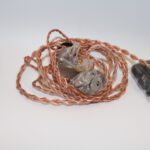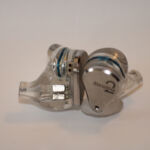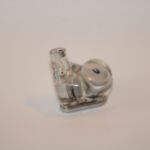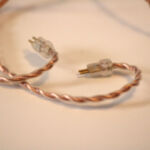Moondrop Blessing 2
disclaimer: The Moondrop Blessing 2 and S8 were sent as part of a Moondrop review tour. I have no financial interest in Moondrop, nor did I receive any remuneration for this review. If you have an interest in Moondrop products, see their website, Facebook page, or to purchase Moondrop products, see HiFiGo.
Unboxing / Packaging:
The Blessing 2 came as part of a tour so my unboxing experience may not parallel the retail experience. I received the Blessing 2 in a lift-top box with the Moondrop logo on front in silver. Lifting the top reveals a case with the earpieces in it and a cardboard box with cable, tips, and manual. I honestly believe this is a far cry from the retail presentation based on other photos I’ve seen so think this discussion is best left at N/A (not applicable).
Build/Fit:
The Blessing 2 uses a 3d resin printed inner shell and a metal faceplate in the now-standard semi-custom shape that I refer to as inverted teardrop. The faceplate has a single vent immediately behind the nozzle with no other venting on the inner shell. The inner shell is transparent resin making it easy to see all the internal components and helping explain the mid-large size of the shell as the 10mm dynamic takes up the better portion of the upper shell while the armatures sit behind the nozzles in the lower section. Nozzles have three sound bores and a mild forward rake. Much like its larger siblings, the Blessing 2 does not have a lip for tip retention and may need to be slightly roughed with steel wool or something similar to get aftermarket tips to stay in place. I had no trouble with the provided tips or spin-fits,but as always it may vary by brand and size. Comfort was good, but with the Blessing2 being a mid-sized in-ear those with small ears may wish to audition before purchase to confirm fit.
Internals:
The Blessing 2 uses a single 10mm dynamic driver for the lows and 4 balanced armature drivers arranged as a pair of each for mids and treble per ear. In many respects the Blessing 2 is the little brother to the s8 as it uses the same Softears custom D-Mid-B mid-range drivers and the same Knowles SWFK dual armature for the highs. The S8 differs in that it uses a pair of armatures for lows instead of the dynamic driver use here and the S8 uses twice the number of mid-range drivers. Nominal impedance is listed as 22Ω with a sensitivity of 117dB/mW. This puts the Blessing 2 in the category of easy to drive in-ears with phones and tablets being the anticipated source gear. I found the blessing did well with phone dongle dacs and any benefit gained from higher powered sources is probably more a matter of improved detail and texture rather than a need for the additional power.
Cable:
The provided cable is 6N oxygen free copper in clear casing that exits the 90º jack as a 4 wire twist. The jack itself is a 3.5mm TRS type in a translucent plastic housing with a good strain relief on cable exit and a velcro cable tie for storage. The splitter is the now familiar Moondrop black coin style with the Moondrop logo on front an a plain reverse. There is no chin slider which I would prefer and the wires exit the splitter as two wire twists up to pre-formed earhooks and .78mm bi-pin connectors. The connectors have housings that match the jack and while labeled R/L on the housing it would be a nice touch to see a drop of red paint on the right side as clear labels on a clear background make for difficulty in finding them. Overall the cable is a solid offering and fitting for an iem at this price point.
Sound:
Bass:
Sub-bass has good depth and rumble as we’d expect from a dynamic but retains enough speed to keep from being loose or dirty. Rumble is quite good when called upon, but does not jump out at the user. There is a mild elevation to the sub-bass but with the total distance from top to bottom being only a few decibels it is hard to think of anything being particularly forward or recessed in the signature. Mid-bass has good attack and slightly slower decay that does give the Blessing 2 a nice tonality with just a touch of warmth to the delivery. Here again, slam is quite good when it is called upon, but the mid-bass does a good job of disappearing into the background and not taking over the signature when it isn’t in a starring role. There is very slight mid-bass bleed but not enough to be obstructive or blurring of the lower mids.
Mids:
I’m a lover of good mids, and the Blessing 2 has great elements here. From the lower mids where male vocals have good note weight and energy, all the way through the upper-mids with its slight lift, they deliver good energy levels without getting too far out in front. Guitar growl is good with nice crisp edges at the low end and violin has enough energy to really sound natural without becoming strident. Unfortunately, cello has some of that hollowness so classically found in mid-tier armature models and the Blessing 2 cannot completely escape from the timbral issues often seen with balanced armature models. Both male and female vocals are on a near even footing with both cutting through the instrumentation but neither feeling disjointed from it. Mids have good detail as well with more micro-detail than expected.
Treble:
Lower treble shares the mild lift of the upper-mids with a gradual climb and then fall again as it moves into the true treble. This gives the signature good energy without getting harsh or sibilant. Snare rattle is believable with good attack and detail and cymbals are nearly as good, if highhat is not quite realistic. The fallback of the treble keeps it from getting strident, but still provides enough detail to keep it from feeling recessed or missing. There is a resurgence around the 10kHz mark before final roll-off above about 13kHz that makes sure the Blessing 2 has some air at the top and even a little sparkle. The treble is maybe the most predictable part of the Blessing 2 as it is good, but very much a BA treble and not a lot different from those found on other models in this price class.
Soundstage / Imaging:
Soundstage is slightly wider than deep but has good dimensions in both so does not feel oddly shaped or congested. The stage also has good height giving it a three dimensional feel better than most offerings at this price and similar to things in higher brackets like the S8 and Sa6. Seating the orchestra is straight forward as instrument separation and layering are both quite good and there are no major overlaps, gaps or anomalies. Imaging is very good with positions being tightly defined in space and movements easily tracked even around center stage where we often find generalization of positions compared to those farther from center. I found little tendency to compress in the lows unless passages got extremely busy and even then the thickening was slight so while there is room for improvement, it is still better than anticipated at this price point.
Thoughts / Conclusion:
Man is this tough. The Blessing 2 does have a few issues with timbre in the mids and lower treble that are not atypical of multi balanced armature models in general, but is entirely better than it should be at the price. Had I not recently reviewed the Dunu Sa6 and Moondrop S8 from the price bracket above the Blessing 2, I might be tempted to say these could compete with models at a much higher price point. Fact is, the new normal is that we can expect excellent in-ears at the $500 mark and there is increasingly less reason to venture above that price point as we have more and more really solid options below. The Blessing 2 certainly fits that description, it may not “punch above its weight class” but at the same time it may well dominate its class for quite some time. If offers the consumer fully 90% of what those two previously mentioned models do and quite frankly has better slam and rumble than either for half the money. Honestly, this and the LZ a7 are probably the best offerings at the price point followed fairly closely by the Spring2. If you are in market for an in-ear with a near neutral tonality and above average dynamics in this price range, you owe it to yourself to audition these.
-
Bass - 8.5/108.5/10
-
Mids - 7/107/10
-
Treble - 7.5/107.5/10
-
Soundstage - 7.5/107.5/10
-
Imaging - 8/108/10
Summary
Pros: good build quality, near neutral tuning, excellent imaging
Cons: some mid range timbre issues, stage size not as large as some




















